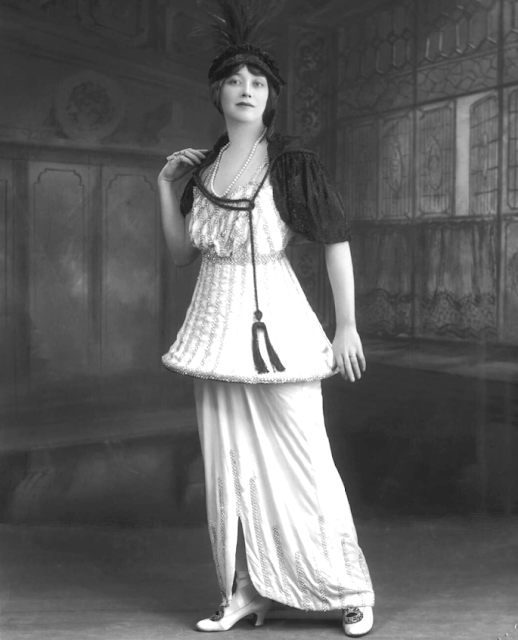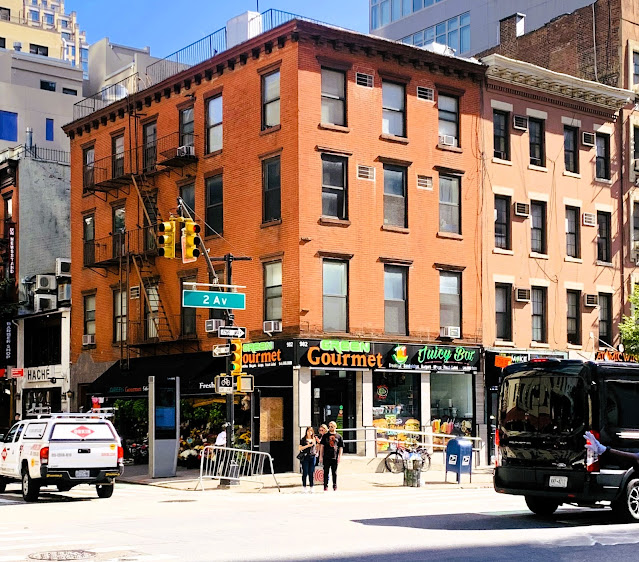In 1898, when Joseph and J. Arthur Pinchbeck commissioned the architectural firm of Neville & Bagge to design a six-story apartment building on the north side of West 93rd Street between Riverside Drive and West End Avenue, there were no other structures on the block. An advertisement for the newly-completed Cliffside the following year boasted, "A magnificent view of the Hudson River and the Palisades...House stands alone and has open sides and rear."
Costing $52,000 to construct, or about $1.89 million in 2023, the structure was a marriage of the Romanesque Revival and Renaissance Revival styles. The rough cut stonework, heavy arched openings, and medieval carvings of the first and second stories were Romanesque Revival. The brick and stone upper floors were decorated with carved panels inspired by the Italian Renaissance.
While the eight-room apartments had gas lighting, an upgrade was available for a cost. An advertisement in March 1899 noted, "electric light from street service if desired." Residents would also enjoy elevator service "until 1 A. M." Rents ranged from $1,200 to $1,300 per year, around $4,000 per month on the high end today.
Ella Grace Larom, an operatic contralto and voice instructor, was an early tenant. While many voice coaches used their apartments as their studios, the highly successful Madame Larom did not. She had a studio in Carnegie Hall and another in Brooklyn.
Among the singer's neighbors was 37-year-old bachelor Isaac M. Hirsch. A salesman for the National Sponge Company on William Street, he was described by The Evening World as "a heavy man, weighing over 200 pounds."
On the morning of January 25, 1904, Hirsch overslept. He had an appointment at 8:30 and did not wake up until after 7:00. The Evening World said he "dressed hurriedly, bolted his breakfast and made the long uphill run to the station." The elevated station was on 93rd Street and Columbus Avenue, "a considerable distance," according to The New York Times.
As he neared the station, the express train was pulling in. Hirsch "went up the stairs two at a time," said The Evening World. Just as he was about to board the train, he fell backward onto the platform dead. The New York Times noted, "An ambulance surgeon gave as his opinion that death was due to the bursting of a blood vessel in the brain, caused by the unusual exertion." Hirsch's funeral was held in his apartment on January 27.
Given that he was closely related to Oliver Hazard Payne, a founder of the Standard Oil Company, it is not surprising that resident H. R. Payne was president of the Union Tank Line Company, the pipeline of the Standard Oil Company. For some reason, he and his wife were not pleased with a romance that blossomed between their son, Ralph Romaine Payne and Mildred Louise Brown in 1912 (despite The New York Press's calling Mildred "a society girl").
Mildred was 19 years old and Ralph was 23. Both sets of parents forbade their marriage. And so the two took matters in their own hands. On the evening of December 29 Mildred told her mother she was going for a walk. "Instead she went to the Hotel Manhattan, where she was met by her fiancé," explained The New York Press. Also waiting at the hotel were two friends, Hazel Guild and Lyman J. Spualding.
"The four were whirled to the home of the Rev. W. R. Ecker...where Payne and Miss Brown were married," said the article. That was the easy part. Now the newlyweds had to break the news to their parents. "The pair then went to Brooklyn, where forgiveness was begged from Mrs. Brown," said The New York Press. Emma L. Brown not only forgave them, but accepted them into her home.
It took a bit more to win over Payne's parents, but on January 6, 1913, Ralph told a reporter that "all had been smoothed over and that they had received the parental blessing." The visit of a reporter from The New York Times to the Cliffside apartment suggested that Paynes had accepted the situation more than they had blessed it. Ralph's mother said, "she was not at the wedding, but insisted that it was not an elopement."
Another highly-visible couple in the Cliffside at the time were Joseph M. Price and his activist wife, Miriam Sutro Price. The couple were married in 1894. While Price was president of the Improved Mailing Case Company, he was best known for his role in politics. He was a key organizer of the Fusion Party and was highly involved in successfully electing John Purroy Mitchel mayor of New York in 1913, thereby defeating Tammany Hall.
A graduate of Hunter College, Miriam Sutro Price was passionately involved in civic issues. She pushed for outdoor spaces for Upper West Side children, and would eventually sit on the executive committee of the National Board of Review of the Motion Picture Industry, serve as president of the Public Education Association, sit on the board of the Manhattan Trade School for Girls, and be a trustee of the Society for Ethical Culture. The Prices would remain in their Cliffside apartment at least through 1919.
Artist Katharine Underhill and her sister Dr. Dorothy Underhill lived here by 1916. The Underhills' summer home was in South Ashfield, Massachusetts.
Another well-respected resident was Joseph Parker Stone who shared an apartment with his widowed father. A graduate of Stevens Institute, the engineer had spent years in South America where, according to the New-York Tribune, he "built many bridges and installed the first elevators in Chile." He was now associated with the Lindeteves-Stokvis firm. In February 1919 the 47-year-old was in South Bend, Indiana on business when he contracted pneumonia. He died there on February 26.
Alice Edmonds was the sister of opera diva Alma Gluck. In 1923, the Edmondses took in Chilean aviator Amilio Kresst Detusschsens and his wife as boarders. Detusschsens was temporarily in New York while "taking a special flying course at Langley Field," explained The Morning Telegraph.
On November 1, 1923, the Edmondses' maid, 26-year-old Amelia Nesbit "suddenly left." Later, Amilio Detusschsens discovered that a purse with $108 he had secreted under a mattress was missing. Police were waiting in the Edmonds apartment on November 6 when Amelia arrived to receive her pay.
Grace La Rue began her career in a tent show. By the time she and her newest husband, actor Hale Hamilton, moved into the Cliffside, she had had an astounding career that ranged from vaudeville to Broadway. She had sung opera and made a recording with Enrico Caruso, and appeared on stage with stars like Al Jolson.
In 1919 she made her first motion picture appearance in the silent film That's Good opposite Hale Hamilton. The couple married on May 29, 1920.
On January 3, 1929, Grace parked her new Nash Coupe in front of the building. When she returned later, the $2,250 vehicle was gone. On March 2, the Biddeford [Maine] Daily Journal reported that police had "uncovered an interstate traffic in stolen automobiles," which included Grace's car. The New Jersey-based criminal syndicate "took orders for particular brands of used cars wanted...and then dispatched one of their men to New York to steal the desired kind of car." Grace La Rue's Nash was found in Jersey City, in the possession of the new "owner."
A terrifying incident took place here later that year. On March 15, real estate broker Richard Dolan was leaving the building along with Catherine Kennedy, another resident. As they reached the foyer, "a man suddenly confronted him and fired three shots, two of them taking effect." The 33-year-old Dolan died on site. Patrick Walsh was arrested "some distance from the scene" by Patrolman William Ryan after a pedestrian told him he had trailed the gunman from the apartment building, according to the Long Island Daily Press.
The days of sprawling apartments, maids and expensive cars came to an end shortly after the building was sold in 1943. A renovation completed in 1948 resulted in 14 and 16 single-room-occupancy rooms per floor.
Today there are studios and small apartments in the building. None of the 1899 interior appointments survive. Although the masonry of the first floor and basement has been painted, and an entrance dating to the 1940s remodeling replaces the original, the Cliffside retains much of its architectural integrity.
photographs by the author
no permission to reuse the content of this blog has been granted to LaptrinhX.com























